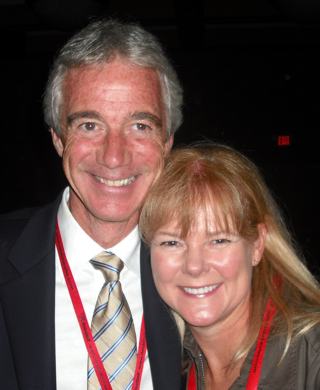By Liz Leamy
The culture of figure skating is ever-evolving, especially in light of the constant changes and development of the International Judging System in the contemporary competitive realm.
No doubt, jumps still play as big a role as ever and any skater hoping to make it to the top of the U.S. or international ladder needs to have an arsenal of clean, big triples and if possible, a quad. In addition, they should be able to do artfully formed, high-accelerated spins. Ultimately, however, these elements donít mean a thing if a competitor cannot skate well, a situation that unfortunately seems to occur more often than one would actually expect. Marks instantly decline when a skater walks through their elements and viewers tend to lose interest, according to IJS officials.
 PSA president David Kirby with Tammy Gambill, U.S. FIgure
Skating representative to the PSA.
PSA president David Kirby with Tammy Gambill, U.S. FIgure
Skating representative to the PSA.
"Skating skills are the foundation of figure skating and they show the relationship between the skater and the ice," said David Kirby, ISU championship IJS technical panel official and PSA president at the 2010 PSA conference in Colorado Springs, Colorado last May. Kirby also said that components are the fundamental aspect of this marking system, and that good skating skills are paramount to earning high program component scores.
"Figure skating is changing and one of the scary words are components-each one is individual but is important for the whole," said Kirby, who gave this seminar with Judy Blumberg, the three-time U.S. World dance medalist and an ISU technical specialist in dance and David Santee, the 1981 U.S. World silver medalist and ISU certified technical specialist.
According to Kirby, Ďcreatingí a skater is comparable to building a car, and can wind up as either a top-of-the line race model or one that is geared toward basic functionality.
Some of the most common mistakes that prohibit development of a fine-skilled skater include stiff knees, bending too far forward, pushing with toe picks, balancing on the incorrect part of the blade, using incomplete stroking edges and short jerky steps, skating in straight lines rather than using curves and edges and skating mostly on two feet rather than one. These characteristics, taken separately or as a collective whole, can prevent the development of a skater into a top contender in a major way.
"How does the skater balance on the blade and is there minimum friction and maximum glide?" asked Kirby, who added, "the majority of the weight should be evenly distributed over the blade, producing good skating quality and technique."
In describing the various aspects of building a premier competitor, Kirby explained that skating skills are the primary element and are like the engine of a car; the transitions are like the transmission and ought to be seamless; choreography is the body, shape and design; interpretation is the paint, lighting and chrome design; and performance and execution represent the wheels and brakes.
"Each component is individual but so important for the whole," said Kirby.
Further, with the latest changes in the IJS at the annual ISU meeting in June (the spirals were dropped from the ladies short and one footwork sequence had been eliminated from the menís short), the components emerge as even more critical than ever.
In marking the components, officials look at the skaterís balance, flow, sureness, speed and direction. Some aspects to consider in regard to these things include knee and ankle action, light strokes, good posture, minimal pushes, sureness and edge quality. Kirby said skating should not appear to be labored and tense and there ought to be efficient and coordinated power combined with strong edges.
This spring, the ISU issued a video with examples of exceptional component skating. Some of the American skaters featured included Brian Boitano, the 1988 U.S Olympic champion and Paul Wylie, the 1992 U.S. Olympic silver medalist, among others. Some officials also recommended viewing videos of such former U.S. Olympic champions Kristi Yamaguchi, Dorothy Hamill, Peggy Fleming, Dick Button and Tenley Albright, as well as the late Bradley Lord, the 1961 U.S. menís titlist.
Meanwhile, Kirby also recommended that coaches pay attention to their studentís directions of skating throughout the program and said that effective changes of direction add great value to a performance.
Finally, it is the responsibility of the skater to have an automatic understanding of each element along with excellent skating skills so that they are able to achieve IJS success. "Too many skaters are trying for level four elements and that goes beyond their skating skill level," said Blumberg. "If they have the skating skills, the rest will fall into place."